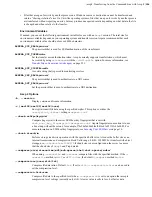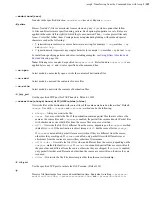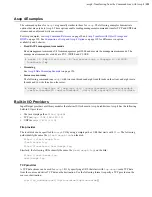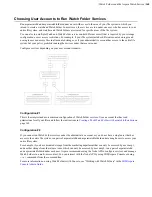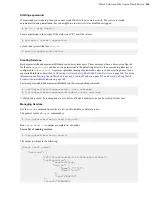
| ascp4: Transferring from the Command Line with Ascp 4 |
153
Ascp 4 Examples
The command options for
ascp4
are generally similar to those for
ascp
. The following examples demonstrate
options that are unique to Ascp 4. These options enable reading management commands, transfer TCP and UDP data
streams, and enable read/write concurrency.
For Ascp examples, see
on page 99 and
Ascp Transfers with Object Storage and
on page 118. See
Comparison of Ascp and Ascp 4 Options
on page 138 for differences in option
availability and behavior.
•
Read FASP4 management commands
Read management commands V4 from management port 5000 and execute the management commands. The
management commands version 4 are PUT, WRITE and CLOSE.
# ascp4 -L /tmp/client-logs -R /tmp/server-logs --faspmgr-io -M 5000
localhost:/tmp
•
Streaming
Ascp 4 Data Streaming Examples
on page 156.
•
Increase concurrency
The following command runs
ascp4
with two scan threads and eight read threads on the client, and eight meta
threads and 16 write threads on the server.
# ascp4 -L /tmp/logs -R /tmp/logs -l1g --scan-threads=2 --read-threads=8
--write-threads=16 --meta-threads=8 /data/100K [email protected]:/data
Built-in I/O Providers
Input/Output providers are library modules that abstract I/O scheme in Ascp 4 architecture. Ascp 4 has the following
built-in I/O providers:
• file (as a simple path or
file://
path
)
• TCP (as
tcp://192.168.120.11
)
• UDP (as
udp://233.3.3.3
)
File provider
The local disk can be specified for
ascp4
I/O by using a simple path or URL that starts with
file
. The following
paths identify the same file (
/test/ascp4.log
) on the disk:
file:////test/ascp4.log
/test/ascp4.log
file://localhost:/test/ascp4.log
Similarly, the following URLs identify the same file (
test/ascp4.log
) on the disk:
file:///test/ascp4.log
test/ascp4.log
TCP provider
A TCP data stream can be used for
ascp4
I/O by specifying a URL that starts with
tcp
.
ascp4
reads TCP data
from the source and writes TCP data on the destination. Use the following format to specify a TCP provider on the
source or destination:
tcp://
ip_address
:
port
[?
option
=
value
[&
option
=
value
]]








